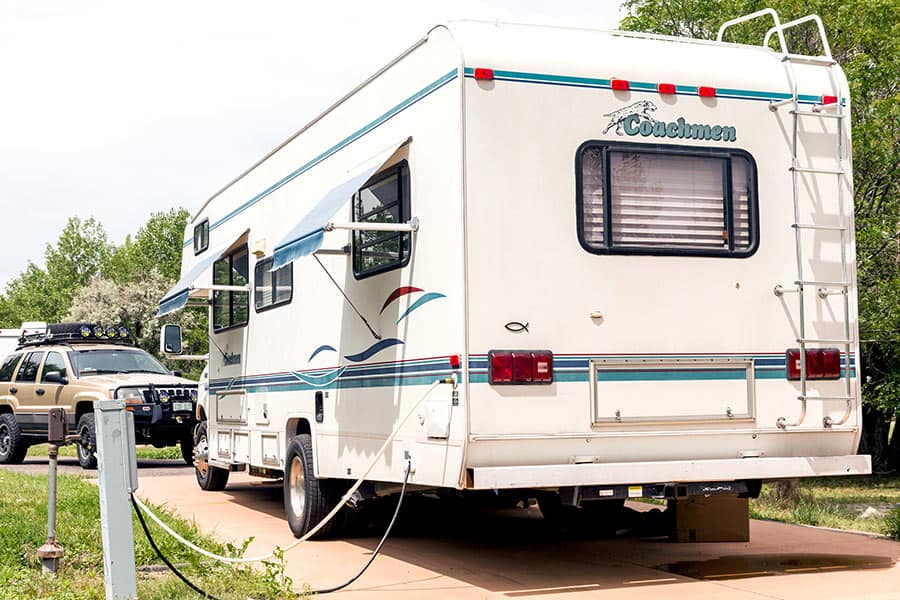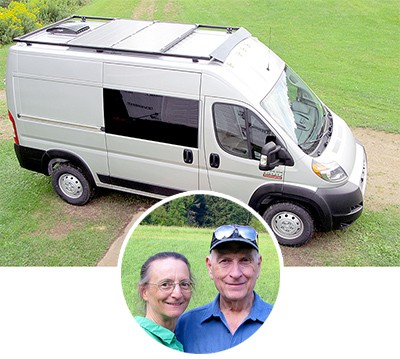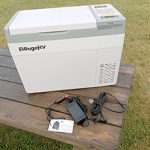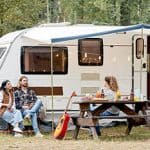
RVs, whether they’re motorized or towable, require power to run any of the electrical devices installed within the camper, either from shore power or batteries. They could also rely on a combination of both sources of power, depending on the RV’s electrical system.
So, what is shore power in an RV? Shore power is the connection of power through an AC electrical grid from an outside power source like an RV campsite’s electrical pedestal to your RV’s power cord. This connection provides a 120-volt power hook up to run various appliances within the RV.
Most RVs come equipped with shore power cords. There are three common connection types, each with a different amperage, more on that a little farther down. Some but not all of the larger campgrounds will have electrical pedestals with all three hook-up types available.
An amp is the measurement of electrical flow. The more amps, the higher the amount of current flowing through the cord to the electrical device. The larger the amperage, the higher the current flow; the greater the power consumed, the larger a power cord that’s required.
RV Electrical System
Understanding the basic concepts of power is helpful in understanding the differences in power in your RV. A basic formula, Watts = Amps x Volts (W=AxV) which will tell you how many different electrical appliances you can have running at one time, or how much power you need to run them.
A watt is the measurement of electrical power usage. The best way to determine power usage is to get it from the device nameplate or user manual. If the manufacturer does not indicate wattage, you can calculate it using the above formula.
Watts represents overall power, which is the product of current or amps and voltage. As long as you know the available wattage and stay under that amount, your electrical circuits will operate normally. However, if you exceed the power limit, you can trip the electrical circuit breaker, something you may have done by trying to run too many devices at once.
AC (Alternating Current) power is current that changes directions in a cycle. In contrast, DC (Direct Current) electricity flows just in one direction.
A lot of RVs have a two-part electric system: a 12-volt DC power and a 120-volt, shore power, electrical system. Batteries power the 12-volt. It is possible your RV has a few batteries, but these batteries are responsible for running items like the water heater, furnace, and lights.
The 120-volt is the more prominent source of power that is required when wanting to run larger appliances like a TV and most kitchen appliances.
Incorporating an inverter for DC to AC power allows you to convert your 12-volt battery power to 120-volt to run larger appliances without being connected to shore power. However, be aware of how long you utilize the inverter at one time because, like all batteries, the power will eventually deplete and need recharging.
That is why it is beneficial to use shore power while at a campground or RV park. When connected to shore power, it may also recharge your 12-volt batteries.
Other Posts of Interest
- When Should I Turn On My RV Tank Heaters?
- The 8 Best Vans You Can Camp In
- Why We Bought A Yeti Cooler
RV Power Source Options
Shore power cords come in two different amperages, 30-amp and 50-amp. To break down the differences, the 30-amp cord has three prongs, whereas the 50-amp has four prongs. As noted above, the larger amperage will provide more power.
There is a third amperage that provides 120-volts, usually found on some of the smaller towables, a 20-amp cord that is a 15/20-amp power system. This system provides 1,800 to 2,400 watts of power.
The 30-amp system also provides 120-volts but offers a larger wattage of 3,600 watts.
The 50-amp four prongs receptacle provides 240 volts, two 120-volt hot wires that supply two separate 50-amp, 120-volt feeds which are divided by the RV’s electrical box and provides 12,000 watts of power.
The difference in power between 30-amps to 50-amps is increased by more than three times. Some RVs have an Electrical Management System (EMS) that automatically shuts off when the power demand exceeds the availability. This acts as a safety precaution before the power surge is too much and damages any components.
Some RVs require 240-volt hook-ups for larger appliances like dryers, but for shore power, only 120-volts is needed. So, it is essential you know how much power your RV can handle using the formula mentioned to ensure protection to your power system.
Campground Electrical Provisions
Again in most cases, campgrounds have provisions to suit your RVs electrical needs. However, depending on the campsite, they may only provide 30-amp hook-ups. Just to be sure, you can ask the campground in advance what type of hook-ups they offer.
Another option is to invest in a dog-bone adapter. A dog-bone adapter will allow you to plug your RV power cord into a 20, 30, or 50-amp receptacle.
Something to keep in mind is when using a dog-bone adapter, if you have a 50-amp power cord, you step down to 30-amps, you will only be able to use 30-amps of power. Meaning, your power is limited and will not be able to provide as if you would when plugged into 50-amps.
It would be unlikely to find a campground that only has 30-amp receptacles. But if you stayed at one and your RV has a 20-amp power cord, you can also use a dog bone adapter to step up to 30 or even 50-amps.
Appliances that Require 120-Volts
Some appliances within your RV require 120-volts such as TV, air conditioner, and microwave, to name a few. Batteries cannot power these appliances unless the RV has an inverter to convert DC power to AC power, or the device is designed explicitly for 12-volt.
When supplying power to your RV, it’s especially important to take a moment to understand your RV’s electrical requirements and connections to prevent any unnecessary problems.
It’s also beneficial to know which appliances utilize more energy than others. Some devices are electricity hogs. That means kitchen appliances like your coffee maker, toaster, and microwave. As well as bathroom appliances are not far behind when it comes to using electricity, items like hair dryers or straighteners use a lot of power as well.
Any unit that pulls heat or makes things cold will also use a lot of power, such as an air conditioner or items that have a motor, motors will use many times the listed wattage when starting. You might be surprised how fast all these items add up and how much power you’re actually using.
Things to Keep In Mind Before Connecting Shore Power
Safety should always be a priority, especially when it comes to electrical currents. While it’s probably not necessary, but checking the power source before plugging your RV in might be a good idea. You could use a voltmeter to verify that the electrical pedestal is wired correctly. This will protect you from frying your electrical devices if the wiring is incorrect.
You can purchase voltmeters at a reasonable price at a lot of big box stores, and it could save you exponentially in the long run if you happen to find a problem.
Also, before connecting to shore power, make sure all the RV’s electrical units or appliances are powered off and that the pedestal’s power breaker is off before plugging the power cord in as well as removing it.
Another preventative item you can purchase is a surge guard to protect the electrical system in your RV from any inconsistent power fluctuations.
Alternatives to Shore Power
In the event you do not have the proper connection for shore power, an alternative resource to power your 120-volt appliances is a generator. A generator allows you to create AC power, which will run those larger appliances.
Although some larger RVs have generators already installed in them that may not hold true for smaller motorhomes. Campground restrictions may be a prohibiting factor associated with generators, but it could be a reliable back up when shore power is not available.
Other resources like solar and wind are available in place of generators and shore power for those who like camping off the grid. However, you will need to remember to have an inverter in order to transfer the power from your solar panels to generate an electrical current to the RV’s appliances.
We have a couple of other posts to give you more information on what an inverter is and another one to help you select an inverter.
Summing It Up
When you can connect your RV to shore power while camping, it helps you to have all the conveniences that you would have at home, so “roughing it” while camping isn’t so bad.
I am sure though that even if shore power isn’t available that you and your family will still have a great adventure while exploring the many camping destinations that there are to visit.






